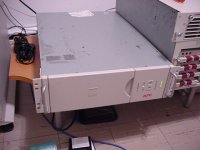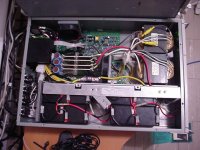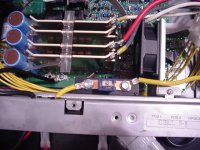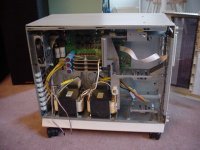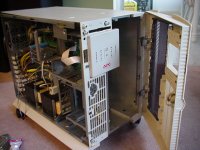Hello. I realize this is kinda off forum topic. But I figure this is the best forum of all the one I know to ask. I am betting the some people in this particular forum have exerpience with this.
Wondering how to extend the battery (and thus uptime) of a UPS. There are some expensive models with external expansion battery packs. Could I take a more reasonably priced UPS, operate a little, and just hook up a huge honkin' external battery in parallel with the internal one? Or perhaps replace the internal one (or two) with the external one (or two)? Not sure what issues may come with having lead acid sealed gell batteries in parallel. Or how this might impact the internal battery charger.
Thanks a lot for any information!
Wondering how to extend the battery (and thus uptime) of a UPS. There are some expensive models with external expansion battery packs. Could I take a more reasonably priced UPS, operate a little, and just hook up a huge honkin' external battery in parallel with the internal one? Or perhaps replace the internal one (or two) with the external one (or two)? Not sure what issues may come with having lead acid sealed gell batteries in parallel. Or how this might impact the internal battery charger.
Thanks a lot for any information!
I've done this myself with a UPS that used two 7 Ah gel cells in series for my home entertainment system. I installed external 17.5 Ah batteries with a quick disconnect inline cable connector designed for high current battery applications.
Because voltage drop in the battery lines can be high due to the large current draw, extend the battery connections only as long as really necessary to reach the external battery and use only an external battery(ies). Using heavier gauge wire won't hurt either. A gel-cell of several times the AH capacity can still be adequately re-charged by the UPS circuit but it will just take that much longer after a use. The thing to worry about more is how well the UPS is designed for duty cycle. A manufacturer making a UPS that is designed to hold a computer up for only as long as it takes to shut it down properly isn't going to build cooling features into their design to allow the UPS to deliver it's max rated output power for an hour or more. You may need to operate the modified UPS with the cover removed and a muffin fan blowing on the power transistor package or/and also power transformer inside to get longer service time under load. You also may need to reduce the max load you expect to keep running on battery backup for a given rated UPS being used for longer backup periods.
Because voltage drop in the battery lines can be high due to the large current draw, extend the battery connections only as long as really necessary to reach the external battery and use only an external battery(ies). Using heavier gauge wire won't hurt either. A gel-cell of several times the AH capacity can still be adequately re-charged by the UPS circuit but it will just take that much longer after a use. The thing to worry about more is how well the UPS is designed for duty cycle. A manufacturer making a UPS that is designed to hold a computer up for only as long as it takes to shut it down properly isn't going to build cooling features into their design to allow the UPS to deliver it's max rated output power for an hour or more. You may need to operate the modified UPS with the cover removed and a muffin fan blowing on the power transistor package or/and also power transformer inside to get longer service time under load. You also may need to reduce the max load you expect to keep running on battery backup for a given rated UPS being used for longer backup periods.
Hey. Thanks for the reply! Yeah, I intended to use heavy guage and keep it close. Had not considered the long term thermal aspect. I should only be using roughly half the wattage (not VA) the unit I have in mind is rated for. So hopefully it shouldn't be too big a deal. What about the charger though. Wouldn't it also be designed with a specific charge time in mind? It might not like having to spend 10x as much time charging.
Do you know what would happen if you paralleled batteries? There might be an issue until the voltages were equalized. Perhaps put a power resistor between them for equalization to limit the current. Then connected straight parallel, they could be charged and drained in unison. Maybe? Or if reverse current through the battery with the lower potential is a problem, perhaps run the UPS off each battery set one at a time and disconnect when reaching a specific voltage. I just hate to waste the batteries in the UPS.
Do you know what would happen if you paralleled batteries? There might be an issue until the voltages were equalized. Perhaps put a power resistor between them for equalization to limit the current. Then connected straight parallel, they could be charged and drained in unison. Maybe? Or if reverse current through the battery with the lower potential is a problem, perhaps run the UPS off each battery set one at a time and disconnect when reaching a specific voltage. I just hate to waste the batteries in the UPS.
You may be thinking too much. Off the top of my head, as long as the charging circuitry can handle the required current (especially at initial charging if starting with low batteries the first time) just wire it up for direct parallel with fat wires and it should be OK. the voltages should all drop at the same time...
...I don't *think* I'm missing something here...
...I don't *think* I'm missing something here...
Many of the cheaper units have calculated battery power such
that the batteries run out before the unit overheats.
that the batteries run out before the unit overheats.
Perhaps some forced cooling would be the solution as rcavictim suggested. I have some super quiet 80mm fans from the computer world. Maybe I can even figure out how to get it to switch on only when operating on battery.
If the batteries have different aamp hours, they would have different internal impeadences. Hope this doesn't effect the operation and charges one battery from the other, it may get hot.
you may want to add a impeadence matching resistor on both batteries, so the percent difference is not to great.
small Ohm-age though.

you may want to add a impeadence matching resistor on both batteries, so the percent difference is not to great.
small Ohm-age though.
Still, if this stuff is for-cheap-or-for-free, wire it up and see what happens. keep a hand on the charger if it doesn't blow up right away and if it gets warm unplug and return to the drawing board.
If the batteries are always under a charge or discharge, then they can be parralled up as needed. But if they are expected to sit for extended time unused, the one weakest one will siphon off the charge of the whole bank unless they are perfectly matched.
hopefully it a older ups. the new ones with smart charging go all
stupid when you mess with the batterys. thay read under charged
or over charged or turn off when the bettery is good and full
one ups that would work is a old rack mount u can put a big honkin battery on that. i am soon
ill post a pic of mine so you can see it could handle it. wires and all
you can put bigger batterys on the small ones but there not made
to run that long. and likelly will die when you need it most😉
heres one lets have a boo inside
stupid when you mess with the batterys. thay read under charged
or over charged or turn off when the bettery is good and full

one ups that would work is a old rack mount u can put a big honkin battery on that. i am soon
ill post a pic of mine so you can see it could handle it. wires and all
you can put bigger batterys on the small ones but there not made
to run that long. and likelly will die when you need it most😉
heres one lets have a boo inside
Attachments
karma said:hopefully it a older ups. the new ones with smart charging go all
stupid when you mess with the batterys. thay read under charged
or over charged or turn off when the bettery is good and full
one ups that would work is a old rack mount u can put a big honkin battery on that. i am soon
ill post a pic of mine so you can see it could handle it. wires and all
you can put bigger batterys on the small ones but there not made
to run that long. and likelly will die when you need it most😉
heres one lets have a boo inside
Thats the same one Im going to use for my 5 channel gainclone 🙂.
Although it looks like yours is the 1200VA version, or maybe more! Mine is only 700VA (times two transformers).
Here is a picture of the top, with transformers in the battery comparments: Top
Front of case
u can reuse the transformers? just wondering i have few laying around. never looked em over for that purpose😀
karma said:u can reuse the transformers? just wondering i have few laying around. never looked em over for that purpose😀
Definately.
Mine are 14.5V AC each, so I hooked up two in series for +/- 20V DC.
I assume yours would be the same voltage.
In having experience with these large transformers, you have to be carful that the surge, the current taken to initially saturate such a huge core, can sometimes cause a breaker to trip. Adding a SMALL resistor in series with the primary coil may help this problem somewhat. or maybe a power factor correction AC cap. You can find these on things like ceiling fans and appliances with AC induction motors in them.
ya i have a few laying around it works. not sure what the va is but when i power this sucker up the table shakes😀 . for a second or two its only 14v. i did a test with it on a gainclone.
it works good. i can push the chip. and there more base. maybe
because of the va? not sure but i like it🙂
it works good. i can push the chip. and there more base. maybe
because of the va? not sure but i like it🙂
i started my mod i used a old server case that would hold the
huge gell cell battery i tested under load with a full charge
5 hours and some. and that with one cell. used for boats😀 . it has wheals so i can move it .better than when it was a rackmount. just need to finish cooling fans 😉
and some. and that with one cell. used for boats😀 . it has wheals so i can move it .better than when it was a rackmount. just need to finish cooling fans 😉
huge gell cell battery i tested under load with a full charge
5 hours
 and some. and that with one cell. used for boats😀 . it has wheals so i can move it .better than when it was a rackmount. just need to finish cooling fans 😉
and some. and that with one cell. used for boats😀 . it has wheals so i can move it .better than when it was a rackmount. just need to finish cooling fans 😉Attachments
- Status
- Not open for further replies.
- Home
- Amplifiers
- Solid State
- extending UPS battery
